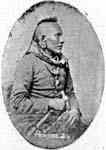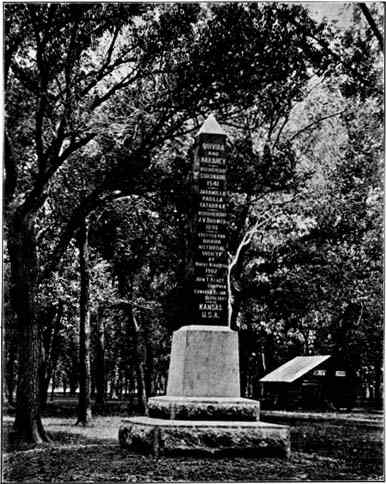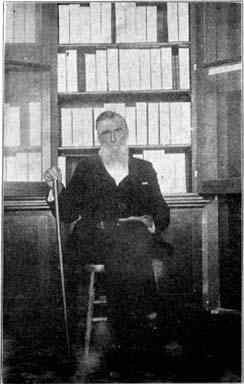|
THE FIRST WHITE MEN CHAPTER IV
Benjamin Gilmore, Blacksmith and Interpreter Otoe
Indians, 1832, 1847. It was on the 29th of May, 1739, that a party of eight Frenchmen,--- Pierre and Paul Mallet, (brothers), Phillippe Robitaille, Louis Morin, Michel Beslot, Joseph Bellecourt, Manuel Galien and Jean David---set out from the village of the Panimaha or Skidi band of Pawnee in northeast Nebraska and became the first explorers of this territory to leave undisputed record of their work. On the second of June they reached and named the river Platte. They followed this to the forks and from there went up the North Platte three days. Finding it leading them in the opposite direction that they wished to go they crossed the neck of land to the South Platte. They continued a southwesterly course, losing seven horses and nearly all their goods in crossing the Arkansas. After many hardships they reached Santa Fe on the 22nd of July where they were cared for by the Spaniards and returned to New Orleans the next year via the Arkansas river. |
northeast, crossed the region now known as Arizona and found in the pueblo towns of the Zuni and Moqui Indians the Seven Cities, but instead of cities of gold and splendor the sunbaked homes of poor people. Greatly disappointed here, Coronado heard eagerly reports of larger and more numerous settlements further east and crossed the desert and mountains into the Rio Grande valley where he found eighty towns of Pueblo Indians irrigating their gardens with the waters of the Rio Grande and dwelling in peace and plenty. Coronado's army spent the winter of 1540-41 in the Rio Grande valley. Their relations with the Indians, at first friendly, became embittered by Spanish greed and arrogance and broke out into revolt. It was a short story. The Spanish veterans stormed the mud walled pueblos, massacred their defenders, reduced the whole valley to servitude and laid the foundation for the Spanish-Indian population and government which has ever since held the valley of the Rio Grande. It is at this time, in the midst of the greatest suffering of the pueblo Indians there appears for the first time the story of Quivira, a rich Indian country far to the northeast where the great King Tatarrax ruled sitting under a tree hung with golden bells which played whenever the wind blew. There was a great river seven miles wide on which floated canoes with forty oarsmen. The common tools and vessels were made of silver and gold and King Tatarrax himself worshipped a "cross of gold"--which certainly sounds familiar to Nebraskans of the present day. This story was told the Spaniards by an Indian from the plains who was held as a slave by those pueblo Indians who lived on the Pecos river in what is now eastern New Mexico. The Indian was called "The Turk" by the Spaniards--because he looked like one as their writers say, and this leads to the surmise that he was a Pawnee and it was the peculiar Pawnee fashion of wearing the hair which reminded the Coronado soldiers of a Turk. After much questioning of 
The Pawnee Indian the Turk, on April 23, 1541, Coronado left the Rio Grande with his whole force of three hundred Spaniards and about seven hundred Indians to seek Quivira. This army traveled thirty-five days from the Pecos river out upon the high plains. Coronado then sent the main army back to the Rio Grande and with thirty picked horsemen and the Turk rode north forty-two days more when he came to the land of Quivira. Instead of palaces with gold and silver he found naked Indians living in straw houses and eating raw buffalo flesh which they cut with knives of flint. There were twenty-five villages of these straw houses in the valley of a very large river. The land was rich and black. There grew wild plums, grapes, walnuts, sumach, mulberries and a kind of wild flax having blue flowers. Coronado says in his report to the King of Spain "the province of Quivira, where I reached it, is in the fortieth degree of latitude." Beyond Quivira was another Indian nation called Harahey. A delegation of these Indians two hundred strong came |
to visit Coronado. They were dressed in breech clouts, carried bows and "wore things upon their heads,"--a description again which points toward the Pawnees. After a stay of twenty-five days in Quivira the Spaniards returned to the Rio Grande, having strangled the Turk, who confessed before his death that he had lied to them about Quivira at the instance of his masters, the pueblo Indians of the Pecos river, in order to lead the army out of their country and into the desolate plains where it might be destroyed. 
Quivira Monument, Junction City, Kansas Was Quivira in Nebraska,--and Coronado the first white discoverer of our state? The question has been fiercely debated by scholars and the last word is not said. In a paper read before the Nebraska state historical society April 16, 1880, Judge James W. Savage, of Omaha, presented the theory for the first time in this state that Quivira was upon the Platte river in the neighborhood of Fremont. There is not space here to give his argument, but it was very plausible, appealed strongly to state pride and was generally adopted. We have |
 |
 |
 |
 |
|
@ 2002 for the NEGenWeb Project by Pam Rietsch, Ted & Carole Miller |
|||
